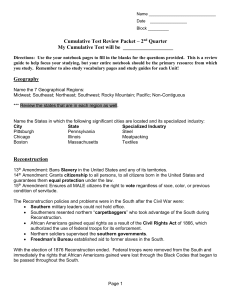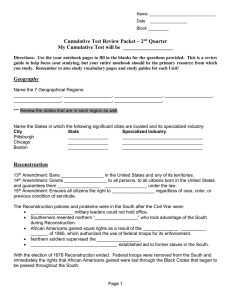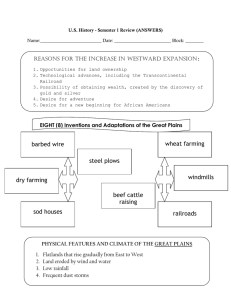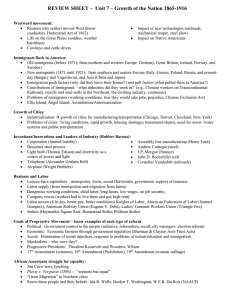2nd Quarter US History Cumulative Test Review Packet
advertisement
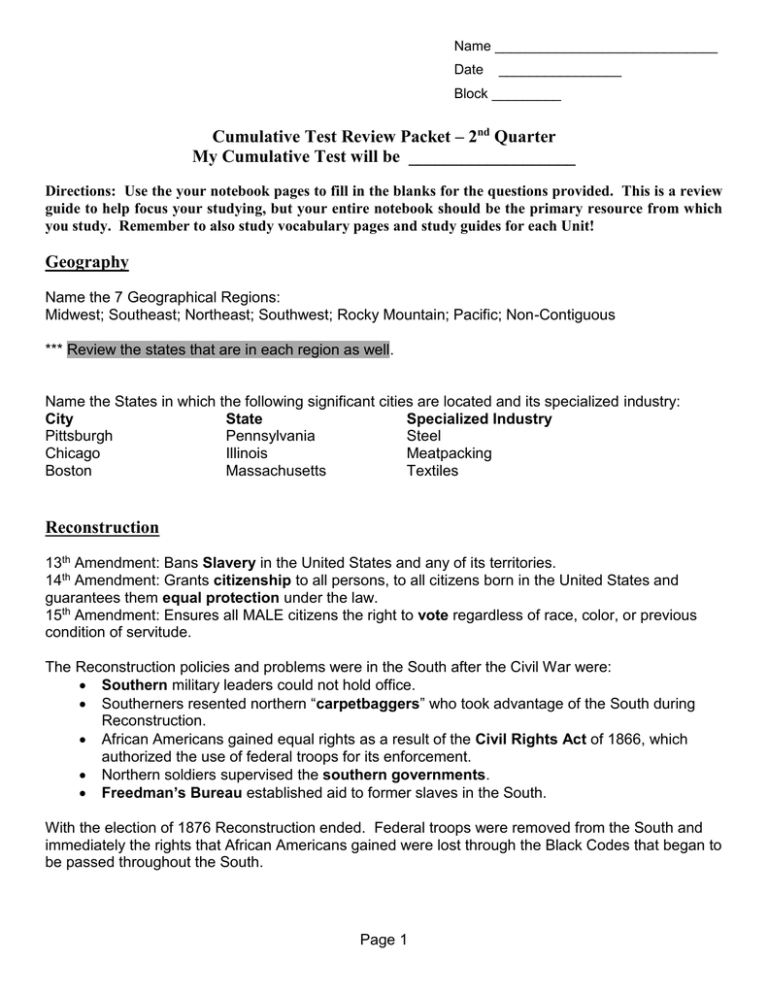
Name _____________________________ Date ________________ Block _________ Cumulative Test Review Packet – 2nd Quarter My Cumulative Test will be ___________________ Directions: Use the your notebook pages to fill in the blanks for the questions provided. This is a review guide to help focus your studying, but your entire notebook should be the primary resource from which you study. Remember to also study vocabulary pages and study guides for each Unit! Geography Name the 7 Geographical Regions: Midwest; Southeast; Northeast; Southwest; Rocky Mountain; Pacific; Non-Contiguous *** Review the states that are in each region as well. Name the States in which the following significant cities are located and its specialized industry: City State Specialized Industry Pittsburgh Pennsylvania Steel Chicago Illinois Meatpacking Boston Massachusetts Textiles Reconstruction 13th Amendment: Bans Slavery in the United States and any of its territories. 14th Amendment: Grants citizenship to all persons, to all citizens born in the United States and guarantees them equal protection under the law. 15th Amendment: Ensures all MALE citizens the right to vote regardless of race, color, or previous condition of servitude. The Reconstruction policies and problems were in the South after the Civil War were: Southern military leaders could not hold office. Southerners resented northern “carpetbaggers” who took advantage of the South during Reconstruction. African Americans gained equal rights as a result of the Civil Rights Act of 1866, which authorized the use of federal troops for its enforcement. Northern soldiers supervised the southern governments. Freedman’s Bureau established aid to former slaves in the South. With the election of 1876 Reconstruction ended. Federal troops were removed from the South and immediately the rights that African Americans gained were lost through the Black Codes that began to be passed throughout the South. Page 1 Lincoln: Reconstruction plan called for reconciliation, preservation of the Union was more important than punishing the South. Lee: Urged southerners to reconcile at the end of the war and reunite as Americans when some wanted to fight on. He became president of Washington College which is now known as Washington and Lee University. Douglass: Fought for adoption of constitutional amendment that guaranteed voting rights, powerful human voice for human rights and civil liberties for all. Racial segregation is based upon race and directed primarily against African Americans but other groups also were kept segregated. How were African Americans discriminated against? “Jim Crow” laws were passed to discriminate against African Americans in the South. These laws made discrimination practices legal in many communities and states. Booker T. Washington: Believed equality could be achieved through vocational education; he accepted social segregation for the time being. W.E.B. DuBois: Believed in equal political, civil, and social rights for African Americans; he did not accept segregation. Moving West The reasons for westward expansion are: Land Adventure Railroad Gold and silver Escape from discrimination People’s perceptions and use of the Great Plains changed after the Civil War. Because of new technolgies, people saw the Great Plains not as a “treeless wasteland” but as a vast area to be settled. The physical features and climate of the Great Plains are: Flat land Little rainfall Erosion caused by wind and water Duststorms Identify eight inventions/adaptations to life on the Great Plains? Steel Plow Barbed Wire Wind Mill Dry Farming Sod House Wheat Farming Railroads Reaper The Chinese Exclusion Act of 1882 was the first attempt to limit the number of immigrants entering the United States. Page 2 Chief Joseph tried to lead his tribe of Nez Perce Indians to Canada to escape the U.S. government’s order forcing them onto reservations after the murder of whites. What was the first phrase of the famous speech/quote he gave upon his surender? “…I will fight no more forever.” What is signifanct about the Battle of Little Bighorn? It was “Custer’s Last Stand.” Custer and his men all died in this battle over territory and gold. What is significant about the Battle of Wounded Knee? It was the last major battle between White Settlers and Native Americans. Immigration and the Rise of Cities Why did immigration increase (Hint: HEAR)? Hope for better opportunity Escape from opporessive governments Adventure Religious freedom Most new immigrants came from South Eastern Europe Europe (Hint: SEE to shining sea…). Most went through the processing center in New York called Ellis Island. Why did cities develop? Specialized industries located in geographic areas including Pittsburgh (steel) and Chicago (meat packing) Emigrate from other countries Movement of Americans from rural to urban areas for job opportunities What challenges faced cities as a result of those social changes? Rapid industrialization and urbanization led to overcrowded cities and immigrant neighborhoods, later referred to as ghettos. Political corruption caused by political machines (Hint: you made your own) Interaction between different cultural groups leads to discrimination against immigrants. o Chinese – because it was difficult for them to assimilate o Irish – because they were Catholic (religious discrimination) What efforts were made to solve immigration problems? Settlement houses, such as Hull House founded by Jane Addams Political machines that gained power by trying to help new immigrants by getting them jobs and citizenship. Inventions: Lighting and mechanical uses of electricity invented by Thomas Edison Telephone service invented by Alexander Graham Bell. Page 3 Industrialization: Rise of Big Business What factors caused the growth of industry and created the rise in big business? Access to raw materials and energy. Availability of work force (or labor force) due to immigration Inventions Financial resources (money) Development of national markets created by transportation advances like the Rail Road and automobile Captains of Industry John D. Rockefeller - Oil industry Andrew Carnegie - Steel industry Henry Ford - Automobile industry Cornelius Vanderbilt –Transportation (shipping) industry Lower cost of production because of the assembly line How did industrialization and the rise in big business influence life on American farms? Mechanization (e.g., machines like the reaper) had reduced farm labor needs and increased production. Industrial development in cities created increased labor needs so farm workers left for the city. Industrialization provided access to consumer products on the farm (e.g., mail order) The Progressive Era Although the Industrial Revolution changed America for the better, it also caused problems. Negative effects of industrialization were: Child Labor Long Working Conditions and low pay Dangerous Working Conditions Women did not have the same rights as men The Suffrage Movement resulted in women attaining voting rights with the passage of the 19th Amendment. How did workers respond to the negative effects of industrialization? Formation of unions– Growth of American Federation of Labor (AFL) Strikes– Aftermath of the Homestead Strike (made strikes unpopular) Workplace reforms included Improved working conditions Reduced work hours Placed restrictions on child labor Page 4 The Spanish American War What were the reasons for the Spanish American War? Protection of American economic interests in Cuba American support of Cuban rebels to gain independence from Spain Rising tensions as a result of the sinking of the USS Maine in Havana Harbor Exaggerated news reports of events, known as Yellow Journalism. What were the results of the Spanish American War? The United States emerged as a world power. Cuba gained independence from Spain. The United States gained possession of Puerto Rico, Guam and the Philippines (Hint: Pop Rocks Go Pop!) Panama Canal Who is famous for the following quote: “Speak softly and carry a bit stick?” Theodore Roosevelt. What does it mean? That you should attempt to deal with other countries peacefully, but when needed we will use force. Which President was responsible for building the Panama Canal? Theodore Roosevelt What were the advantages for the United States to building the Panama Canal? American ships could move more quickly and safely between the Atlantic and Pacific Oceans which were now linked. The navy would be better able to defend America’s new Territories Reduced shipping costs for American shipping vessels which means American businesses would benefit financially. Page 5 World War I What were the reasons for the United States becoming involved in World War I? Inability to remain Neutral Submarine warfare— sinking of merchant ships and the Lusitania U.S. economic and political ties to Great Britain The ZimmermanTelegram Who were the Allies in WWI? United Kingdom (Great Britain); France; Belgium; Italy; Japan; United States Who were the Central Powers in WWI? (Hint: Think GABO) Germany; Austria-Hungary; Bulgaria; Ottoman Empire Page 6
